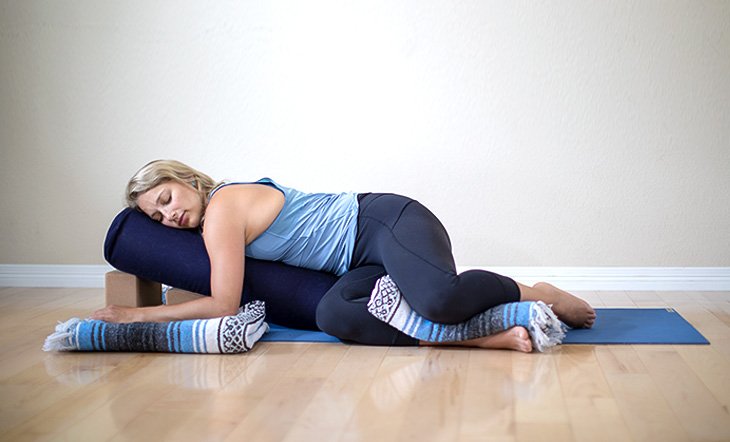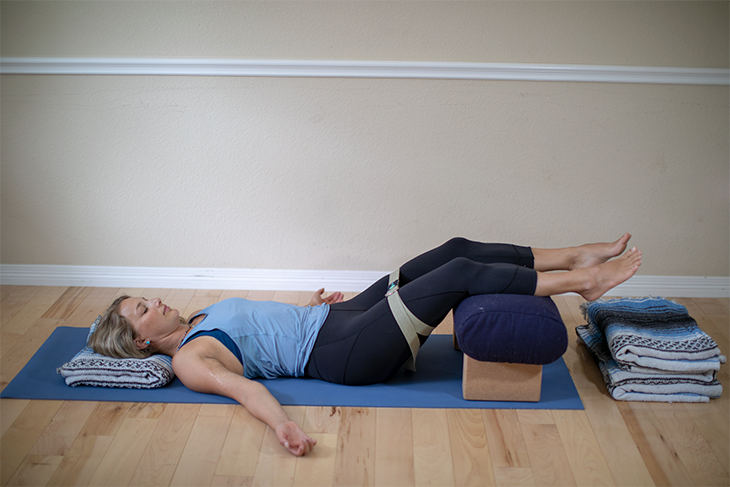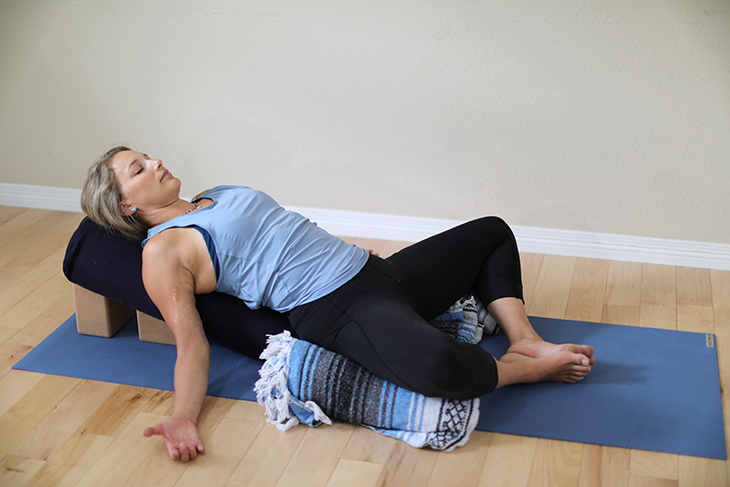Allie Geer, Articles, In the Press, Internal Medicine, Resources, Yin, Restorative and Meditation, Yoga Medicine® News
Try These 4 Restorative Yoga Poses to Relax Your Body & Mind
Senior Yoga Medicine® teacher and therapeutic specialist, Allie Geer, explains why the power of restorative yoga is not to be underestimated.

As a teacher and practitioner of restorative yoga I often come to wonder how I ever got by without this practice. More than ever, students are turning to this form of yoga as a way to alleviate stress.
Stress in small doses can be a very adaptive, natural, and healthy experience for your body. However, we run into trouble when the body becomes chronically stressed.
Restorative yoga provides us with tools and techniques to help us better manage the symptoms of stress and chronic stress.
When we learn to cope with stress, we can support our body’s natural rhythms and cycles. Restorative yoga encourages the body’s innate capacity to heal.
The ability to relax is truly a learned habit, and must be practiced over time and with patience. The first time you try restorative yoga, you might struggle to get comfortable. You might fidget and move around throughout class. Just know that this is OK.
Sometimes, the biggest hurdle is giving your body permission to rest. I also encourage you to get curious and to notice the effects the restorative yoga poses have on your body, breath, and even your heart rate.
The Benefits of Restorative Yoga
Restorative yoga is a practice that effects the body from the inside out. It targets our nervous system, our digestive system, and also has a direct impact on all the internal systems within our body.
It helps restore our body’s natural capacity for health by targeting the parasympathetic nervous system. The parasympathetic nervous system is a branch of the nervous system that regulates our body’s ability to rest, digest, and heal.
When we can balance the nervous system and activate the parasympathetic response. This response will help us manage the symptoms of stress and fatigue.
Restorative Yoga: Here’s What You Need to Know Before You Get Started
Unlike other styles of yoga, restorative yoga is a passive and deeply receptive practice. Typically poses are held anywhere from 5-25 minutes. Sometimes, it includes the use of yoga props to set the body up to be as comfortable as possible.
There is little to no muscular activity. The goal is not to stretch or stimulate our tissues. Once we settle into a pose, we stay. We become a witness to our internal environment within our body.
If you are new to restorative yoga, try the following sequence. The props suggested include a strap, a bolster, two blocks, and four blankets. However, if you don’t have the suggested props, you can always modify with scarves, towels, pillows, couch cushions, and even large books in lieu of the blocks.
The goal is to rest and set your body up so that you give it permission to just be, relax, unwind, and nourish from the inside out.
This short sequence is one of my go-to sequences whenever I need a system reboot and overall the class could take you anywhere from 30 minutes to an hour. It’s up to you how much time you can carve out.
The longer you can hold, the better. Try setting a gentle timer or just come out of the pose when you feel ready.
Try These 4 Restorative Yoga Poses to Relax Your Body and Mind:
Before you begin your practice, take a few moments to ground. Find a comfortable seated position that will allow you to feel the weight of your sit bones dropping into the earth.
Then, take a moment to welcome the breath into your body. Begin to observe the breath in its natural state.
Take three vocal sighs out through your mouth for three exhales. If possible, try to sit for a few moments just observing your breath and sensations within your body without the need to change, interpret, or shift anything. Linger in the exhalations.
1. Legs on the Bolster
Suggested props: 1 blanket, strap, bolster, 2 blocks, or a wall
This gentle inversion massages your heart and improves blood flow and circulation. It helps to calm your mind and nervous system. It also alleviates soreness due to muscle aches and pains in the legs and feet.

Let’s try it:
- Take two blocks and set them towards the end of your mat on the medium height
- Place the bolster on top of the blocks, like you are making a table
- Loop your strap, and slowly come down on to your back. Place your legs on top of the bolster so that the calves are fully resting on top of the bolster with the legs at about a 90-degree angle
- Place the strap around your mid-thigh to allow your hips to feel fully relaxed and supported
- Additionally, for extra comfort place a blanket under your head and perhaps one on top of your belly. Stay in this pose anywhere from 5-20 minutes
Once you arrive into the posture allow a few moments to settle in. Welcome your breath into your body and begin to visualize fatigue, tension, and stress slowly draining out of your body starting at your feet.
Take your time transitioning out of the posture. Making mindful, easy movements arriving back to a seat. You can also modify this posture by elevating your legs on a wall instead of a bolster.
2. Elevated Prone Twist
Suggested props: 4 blankets, 2 blocks, 1 bolster
Twists, and this twist in particular, offers gentle stimulation for the digestive organs, liver and spleen. It can help alleviate tension in the muscles of the back and hips and gently stretch your intercostal muscles between your ribs to enhance your breathing.

Let’s try it:
- Start by placing one block on the medium height and one on the lower height. Place your bolster on top of the blocks so the bolster slopes downward
- Place a blanket in front of the bolster. Sit on the blanket with your right hip next to the bolster and the knees stacked
- Place a blanket in between your knees. Place a blanket on each side of the bolster to support your arms
- Begin by sitting upright and connecting to the breath, feeling the pelvis drop into the floor. Slowly rotate your torso towards the bolster and recline down on top of it
- Switch sides
Settle in and stay for 5-10 minutes before switching sides. Allow the props to support the body. To modify, this pose can also be done without using the blocks for elevation.
3. Supta Baddha Konasana or “The Goddess”
Suggested props: 4 blankets, 2 blocks, 1 bolster
Supta Baddha Konasana softens your shoulders and relaxes your chest, abdomen, and pelvis. It can be helpful during menstruation, menopause, and pregnancy.

Let’s try it:
- Keep the same prop set up as the previous pose with the bolster and blocks elevated and the blankets to each side
- This time, sit in front of the bolster with the sacrum as close to the edge of the bolster as possible. Bring the soles of your feet to touch and let your knees open wide as if you were making a diamond shape with your legs
- Slowly recline down onto the bolster and tuck the rolled blankets beside you under your hips
Should you need more support, add another blanket under your head and neck and a blanket to cover for warmth. Option to add an eye pillow for your eyes. Stay in the pose anywhere from 5-20 minutes.
To modify, adjust the height of props to personal comfort.
4. Supported Savasana
Suggested props: 4 blankets, 1 bolster, optional strap
Savasana seals your practice and allows your entire body to relax by inviting it to find a deeply restful and supportive state.
This pose encourages rest and repair of tissues and helps ease stress, anxiety, tension and insomnia while balancing your parasympathetic response in the nervous system.

It is important to take the time to set up Savasana to provide maximum amount of comfort for your body.
Let’s try it:
- Try setting up in Savasana by laying down with a bolster under your knees, a rolled blanket under your ankles, and a rolled blanket to support the curvature of your neck
- Support for your neck is key here to really tap into the parasympathetic response
Get the most out of the pose by adding the weight and support of a sandbag or pillow on top of your belly. Rest in Savasana anywhere from 5-25 minutes. Feel your body fully supported and landing onto the earth. Give your body permission to relax and be at ease.
Do You Feel Relaxed After These 4 Restorative Yoga Poses?
Restorative yoga is a practice that nourishes the body from the inside out. It is a practice of non-judgment. It is a practice of curiosity and tuning in to your body’s internal state.
Restorative yoga taps into our body’s natural capacity to heal and maintain a healthy state of balance. I hope this practice helps you feel deeply rested, supported, rejuvenated, and restored.
Rest is best, especially when we are feeling tired, stressed, and overwhelmed. May this practice be of benefit. Namaste Yogis!
Want more Restorative Yoga with Allie?
Take her 32-Minute Restore class on YA Classes
***
Find the original article on Yogi Approved.













